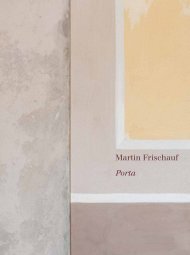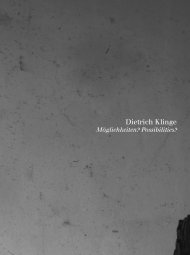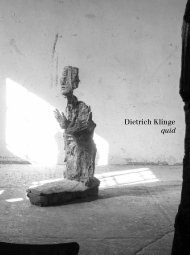Katalog_Portus_für_Jumpu
Create successful ePaper yourself
Turn your PDF publications into a flip-book with our unique Google optimized e-Paper software.
Beyond Place: The Portus
Gustave Courbet’s monumental painting, The Painter’s Studio, of
1855 is an icon of the Realist movement which flourished in France,
and slightly later throughout Europe, in the middle of the 19 th century.
The master is seated before a large canvas at center and gathered
around are a host of poor and working class individuals, and
a sprinkling of the literati and intelligentsia of the day. The world
as it was known was in the midst of or on the verge of great change
studiously suggested by the populace gathered. The studio space itself
is vast and filled with elements, like the population, which offer
insight to the artist’s oeuvre. In totality, the painting is often seen
an allegory of Courbet’s art: present conditions and past references,
physical realities and suggested psychologies. Timeless longings
and aspirations.
In the spring of 2020 – in the midst of the silent chaos of a global
pandemic and economic unraveling – the widely acclaimed German
sculptor Dietrich Klinge quietly opened a new space for his
art in the bucolic village of Weidelbach in the northern-most part
of Bavaria. Far from central to the art world, past or present, Weidelbach
is populated by an array of sturdy traditional houses and
farms; many are historic while others pay modest but sincere homage
to the past. A church and courtyard are at the center. Klinge
himself renovated the 18 th century mill as his home and a studio for
smaller sculptures and graphic enterprises between 1991 and 1999.
He built a large studio for sculpting in a complimentary style to the
old mill in 2000. The structure is barn-like and private but fronted
by a rustic orangerie, which was added in 2001 and is organized and
utilized by his wife Christina, a master gardener beyond compare.
92 93
Called the Portus, from the Latin meaning “harbor”, everything
about the new space and its contents has been carefully planned
and organized by the artist. As with the creation of his sculptures,
the space resulted from a rigorous cycle of reflection and planning,
planning and reflection before the physical act of construction itself.
The design and details are totally his own. On the exterior, the Portus
pays homage to the previously discussed home and studio weaving
itself into the visual fabric of Weidelbach’s historic environs. As
it sits on the edge of Klinge’s property and henceforth on the water’s
edge of the village, the newness of the structure successfully melds
into an historic aesthetic that fails to call attention to itself but contributes
to the sense of rural timelessness so prized in the region.
Elongated and slightly narrow, the building modestly climbs two
stories. To the casual passerby the exterior of the Portus succeeds
in its discretion and fails to signal much notice. However more than
a façade, the exterior is rather a skin which wraps and protects the
artist’s vision. The interior is populated by an extraordinary array
of objects, contemporary and historical, which quietly speak individually
and in relation to one another.
One of the most important figurative sculptors of our time, Dietrich
Klinge has created a vast and important repertoire which has
been eagerly exhibited and collected across Europe, the United
States and Asia since the 1990s. Momentum among both private
and public collections has expanded in recent decades owing to
both the compelling nature of the sculpture and Klinge’s extraordinary
work ethic. For the sheer scale of his output it is astonishing to
consider the vast amount of silent contemplation forerunning each
sculpture as part of its inception, and the mere fact that he is singularly
involved with the creation of every work. This said, with the
exception of the foundry work, the artist works alone – even fully
responsible for the patina of every bronze. Prodigious and prolific,
Klinge had long considered the importance of a space which would
allow for the display of a sampling of work beyond the calendar
limitations that his many museum and gallery exhibitions offer.
















